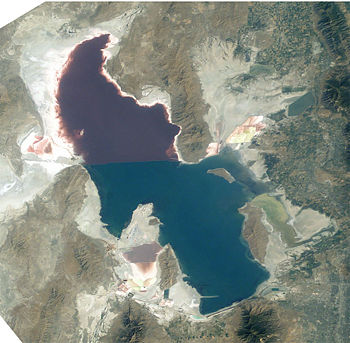Halobacterium NRC-1
Ecology

Halobacterium NRC-1 is one of many strains of halobacterium which thrive in extremely high salinity environments such as salt lakes, salt marshes and salt drying ponds. Their optimal temperature for reproduction is 42°C. Often these highly saline bodies of water will be tinted red or purple. It is the red/purple color of the bacteriorhodopsins that give the purple color you often see in these highly saline environments. Bacteriorhodopsin consists of a photosensitive protein pigment called retinal. This protein pigment is responsible for NRC-1's colorful properties. The more saline the environment the more colorful the water will be because halobacterium increase their production of bacteriorhodopsin in response to drops in oxygen which is less soluble in saline solutions.
There are not many other organisms that can survive in these high salt environments, in fact one of its primary sources of food is the amino acids of other organisms which have lysed due to the high salt concentration in this environment. Brine shrimp are one of a few other organisms that can survive the high salt concentration, and they feed almost exclusively on the halobacteria. In addition to rhodopsin, Halobacterium NRC-1 produce carotenoids, which are red organic pigments that can also serve as antioxidants. The flamingo, whose pink color comes exclusively from the carotenoids in its diet (it doesn't have the ability to produce these pigments naturally ) feed on the brine shrimp (who are capable of producing these pigments). These same brine shrimp have fed on the carotenoid producing halobacteria. So interestingly enough, these small organisms, the brine shrimp and the halobacteria, are the ones responsible for the flamingos beautiful pink coloring.